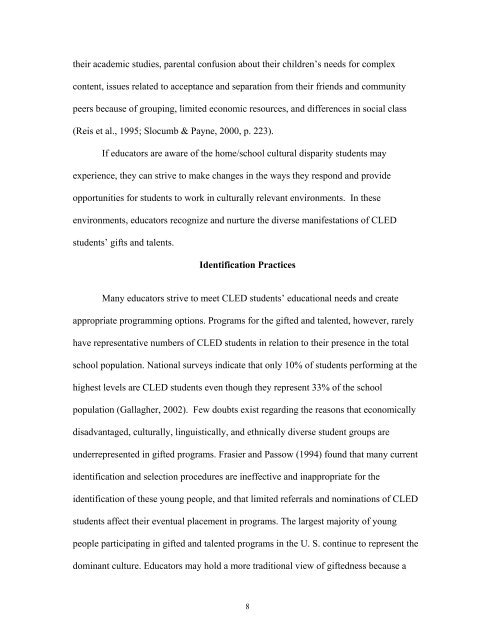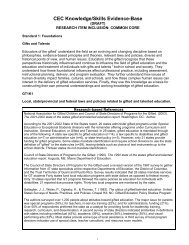Chapter One An Introduction to the Topic of Cultural Diversity - NAGC
Chapter One An Introduction to the Topic of Cultural Diversity - NAGC
Chapter One An Introduction to the Topic of Cultural Diversity - NAGC
Create successful ePaper yourself
Turn your PDF publications into a flip-book with our unique Google optimized e-Paper software.
<strong>the</strong>ir academic studies, parental confusion about <strong>the</strong>ir children’s needs for complex<br />
content, issues related <strong>to</strong> acceptance and separation from <strong>the</strong>ir friends and community<br />
peers because <strong>of</strong> grouping, limited economic resources, and differences in social class<br />
(Reis et al., 1995; Slocumb & Payne, 2000, p. 223).<br />
If educa<strong>to</strong>rs are aware <strong>of</strong> <strong>the</strong> home/school cultural disparity students may<br />
experience, <strong>the</strong>y can strive <strong>to</strong> make changes in <strong>the</strong> ways <strong>the</strong>y respond and provide<br />
opportunities for students <strong>to</strong> work in culturally relevant environments. In <strong>the</strong>se<br />
environments, educa<strong>to</strong>rs recognize and nurture <strong>the</strong> diverse manifestations <strong>of</strong> CLED<br />
students’ gifts and talents.<br />
Identification Practices<br />
Many educa<strong>to</strong>rs strive <strong>to</strong> meet CLED students’ educational needs and create<br />
appropriate programming options. Programs for <strong>the</strong> gifted and talented, however, rarely<br />
have representative numbers <strong>of</strong> CLED students in relation <strong>to</strong> <strong>the</strong>ir presence in <strong>the</strong> <strong>to</strong>tal<br />
school population. National surveys indicate that only 10% <strong>of</strong> students performing at <strong>the</strong><br />
highest levels are CLED students even though <strong>the</strong>y represent 33% <strong>of</strong> <strong>the</strong> school<br />
population (Gallagher, 2002). Few doubts exist regarding <strong>the</strong> reasons that economically<br />
disadvantaged, culturally, linguistically, and ethnically diverse student groups are<br />
underrepresented in gifted programs. Frasier and Passow (1994) found that many current<br />
identification and selection procedures are ineffective and inappropriate for <strong>the</strong><br />
identification <strong>of</strong> <strong>the</strong>se young people, and that limited referrals and nominations <strong>of</strong> CLED<br />
students affect <strong>the</strong>ir eventual placement in programs. The largest majority <strong>of</strong> young<br />
people participating in gifted and talented programs in <strong>the</strong> U. S. continue <strong>to</strong> represent <strong>the</strong><br />
dominant culture. Educa<strong>to</strong>rs may hold a more traditional view <strong>of</strong> giftedness because a<br />
8

















